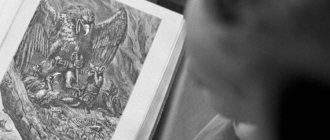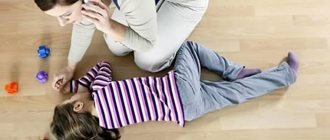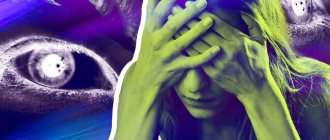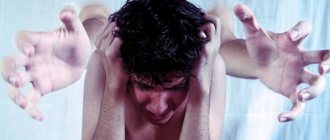It is difficult for any parent to imagine that their child may be susceptible to any mental illness.
However, unfortunately, recently, a disease such as schizophrenia in adolescents is being diagnosed more and more often. At the initial stage of development it is very difficult to establish the correct diagnosis, so it progresses quickly. And this is truly scary.
Here is a far from complete list of questions that concern parents who have noticed something strange in their child’s behavior:
- What is the cause of the development of mental disorders in children?
- What you need to know about the first signs of teenage schizophrenia?
- How to recognize a mental disorder in a child’s changeable behavior?
- How to properly diagnose and treat this disease?
- Is it possible to get rid of schizophrenia forever?
- Is there a possibility that mental disorders will go away along with adolescence?
There are answers to these questions.
Causes
The exact cause of the development of schizophrenia in adolescence is not known for certain. However, we can confidently say that there are factors that have a direct impact on the formation of the disease. These include:
- hereditary predisposition;
- stressful situations;
- complex family relationships;
- computer addiction;
- drug use;
- smoking, childhood alcoholism.
Through many years of research, it has been proven that a teenage child is twice as likely to develop schizophrenia if this disease was previously detected in one of his relatives. The likelihood of a mental disorder increases significantly if both parents suffer from schizophrenia. Heredity has a huge influence on the formation of personality traits.
Stress is known to be the cause of many diseases, and schizophrenia is no exception. Excessive experiences, combined with the unformed psyche of a teenager, form the basis of first emotional disruptions and then severe psychoses. And they already entail schizophrenic disorders.
A turbulent situation in the family, conflicts with parents, youthful maximalism - all these are attributes of adolescence. They may well become the impetus for the development of the disease. A teenager who does not find support and understanding for a long time loses self-esteem, withdraws into himself and becomes depressed. You cannot do without the help of a psychotherapist in such a situation.
Excessive passion for computer games is the scourge of our time. What does schizophrenia have to do with it? It's simple. During the game, the perception of real events occurs. The more a teenager is attracted to the computer, the thinner the line between the real and virtual world. The understanding of all life events changes dramatically. Hallucinations and delusions are perceived as part of the game, and the child has no desire to leave it. Parents do not see anything unusual in the fact that he is talking to himself, but it is at this moment that they need to start sounding the alarm.
Drugs, alcohol and cigarettes in themselves are unacceptable things for a teenager. They have a negative impact on the physical condition of a still fragile child’s body, leading to general intoxication and mental retardation. But the worst thing is that the brain cells suffer from this. An incompletely formed psyche under the influence of narcotic substances can provoke a malfunction leading to schizophrenia and other severe disorders of consciousness.
Depressive psychosis - symptoms and signs
A psychotic episode contains 2 main components. In diagnosis, the doctor relies precisely on their presence.
During examination and questioning of the patient, the following are determined:
- Hypotymia is a depressed state and mood.
- Bradypsychia is a slowdown of all mental processes, in particular reactions to ongoing events and inhibited thinking.
Clinical stages:
- Initial. An ill person experiences increasing depression of all psychophysical functions. Lost interest in work and study. Family relationships are deteriorating. Everything that happens around me is burdensome. Appetite decreases. The patient withdraws into himself and tries to be alone all the time. He experiences insomnia and night terrors.
- Increasing signs. The symptoms described in the initial stage progress. The sick person does not leave the home, sits motionless all the time, avoids conversations and any contact with people. He eats only under duress and hardly sleeps.
- Maximum violations. At the height of internal experiences, the patient develops delusions, most often of the nature of self-accusation. Severe phobias, hypochondria, and suicidal alertness appear. Delusions are accompanied by hallucinations filled with fears.
- Reverse development (regression). All painful manifestations begin to gradually subside. The person returns to normal with residual complaints.
Manifestations of the disease
Unfortunately, there are no symptoms that can be detected to clearly indicate that a teenager is developing schizophrenia. Each case is individual. It would seem that similar manifestations in one child may indicate a serious illness, while in another it is just character traits, gaps in upbringing, or simply a bad mood.
The main signs of schizophrenia are of three types:
- Negative. They represent disorders of the psyche and some body functions. Certain emotions simply become inaccessible to a teenager. He loses the ability to think logically, plan his actions, and take responsibility for his own actions. From the outside, this may look like aloofness, isolation, or simple laziness. These symptoms are quite difficult to identify and correctly qualify.
- Positive. In fact, there is nothing good, much less positive, about them. Symptoms have this definition because they are acquired by the body as the disease progresses. These include hallucinations and delusions.
- Cognitive. They manifest themselves as a failure of mental functions, apathy and indifference. Concentration and the ability to remember and use information suffer. These violations are difficult not to notice during close contact with the child.
At the initial stage, the teenager perceives hallucinations simply as his overdeveloped fantasy. Moreover, they can be visual or auditory, or combined with each other. Only over time does the child realize that something is wrong with him. The situation is complicated by the fact that the psyche is not yet fully formed, so it is impossible to predict the consequences of schizophrenic attacks.
During the period of exacerbation, the teenager loses his sense of reality. He is confused and depressed, there is no sense of social balance. The mood can change sharply and unpredictably, emotions do not always correspond to the situation. Progressive schizophrenia does not allow active communication with others - there is autism, unsociability and apathy.
By withdrawing into himself, the child is left alone with the problem. Typical situation of the initial stage of schizophrenia:
- a teenager hears some voices in his head;
- sometimes it seems to him that they are reading his own thoughts out loud;
- he is visited by various visions;
- there is a feeling of being watched or followed.
But the worst thing is that the child cannot tell anyone about this: the parents are too busy with work or themselves, friends will most likely perceive such a story as another reason for ridicule and bullying. Therefore, there is nothing left to do but fight your own fears alone.
And only when the symptoms of schizophrenia get out of control does it become impossible to hide the disease. If this happens, you should immediately contact a specialist. Undiagnosed mental disorders in adolescence can have very dire consequences.
It is worth noting that in most cases, schizophrenia in adolescents distorts emotional perception or develops dysfunction of thinking and perception of information. But, at the same time, surprisingly, the disease does not affect intellectual abilities. That is, visible changes occur in the child’s behavior, but if he studied well at school, he continues to do so.
Borderline psychopathology
To begin, I would like to talk about borderline psychopathology, which often does not require any active psychiatric treatment, any drug intervention, or hospitalization.
In this case we are talking about behavioral disorders
, when those very violent emotions in behavior, when that very opportunism turns a person into a prickly creature, categorically refusing to discuss any issues peacefully, acting as a war against everyone.
In such situations, we talk about personality disorders, and this is a diagnostic category that exists in the classification of diseases. However, we still do not consider it a disease, since it is a character condition.
Character is not a disease
, character is what is given to a person by nature from birth. This is something that is being formed one way or another. And this is precisely the final phase of character formation, the very puberty age that we are talking about now. And this pubertal age, which lasts from approximately 11 to 17 years, is the determining age in the final formation of character traits.
After 17 years, the character that has been formed will remain unchanged, and all its pros and cons, positive and negative, strengths and weaknesses, as formed by this time, will remain so until the end of life.
I’m talking about this specifically in order to focus the attention of loved ones, relatives and, above all, parents on the significance of every psychological nuance associated with upbringing, or nuance associated with the attitude towards the problems of a teenager in his future life.
What seems unimportant, insignificant or insignificant to us adults, or what seems to us to be a rather successful pedagogical move, for a teenager can turn out to be an event with fatal consequences.
Determining the diagnosis
Analyzing visible and hidden symptoms and making an accurate conclusion is already a big step towards getting rid of the disease. An incorrect diagnosis leads to incorrect treatment. As a result, instead of recovery, the disease drags on and progresses, and it becomes much more difficult to cope with it.
Some people generally refuse to recognize schizophrenia in adolescents as a disease. They associate unusual behavior with:
- lack of vitamins and microelements in the body;
- metabolic disorders;
- general fatigue;
- characteristics of the personality's psychotype;
- influence of external factors.
However, schizophrenia exists, and it begins in adolescence. The slightest deviation in a child’s behavior should be a reason to contact a psychiatrist.
To identify the diagnosis, the child is monitored for at least six months. There is no way to do this before, since the symptoms and course of the disease may change.
To exclude tumors and other brain diseases, it is necessary to conduct the following studies:
- Magnetic resonance imaging;
- electroencephalography;
- general and biochemical blood test;
- state of immune status;
- assessment of hormonal levels.
Specially designed psychological tests play a major role in diagnosing schizophrenia in adolescent children. With their help, you can determine which brain structure is most affected by the disease. Information provided by parents and other relatives who have close contact with the patient is also taken into account.
Analyzing the literature data on the current state of the problem, one can note the contradictory ideas about the clinical picture of schizophrenia in children and adolescents with this range of disorders, the incompleteness of information about the age-related evolution of delirium in the range of different forms of the disease and the insufficient clarity of the prognosis of these schizophrenias (1-18).
In this report we will talk about a variant of acute childhood and adolescent schizophrenia with affective-delusional and hallucinatory-delusional attacks.
12 children and 25 adolescents with schizophrenia and affective-delusional attacks were examined. The disease manifested itself at the age of 5-15 years. 95 attacks were studied, of which 39 were primary and 56 repeated. The duration of clinical follow-up was from 3 to 8 years.
In 18 patients, a few months before the manifestation of the process, moodiness, affective lability, as well as erased unipolar and bipolar mood disorders were detected. In two thirds of the observations there was depression with anxious fears and obsessions. In adolescents, depression occurred with loss of interest in the environment, life, and senesto-hypochondriacal manifestations. In the remaining third of observations, hypomania occurred, veiled by motor disinhibition, activity, talkativeness, and psychopathic manifestations in behavior. Hypomania was mild and, as a rule, short.
In these patients and the remaining 14, the latter - after episodes of obsessions, against the background of erased neuropathic manifestations, less often - of relative health, states of anxious mood developed with fear, sleep disorders, and frightening dreams. Adolescents also developed a feeling of impending disaster, a threat to existence, a fear of going crazy, and the presence of strangers. The surroundings began to be perceived as delusional, acquired an ominous, gloomy, unfamiliar appearance, fraught with a threat (“The gas water pump is evil”..., “The door with a chain is a policeman who could strike”...).
At the same time, a number of patients developed acoasmas, calls, auditory deceptions, photopsia (“The mouse squeaks”..., “The elephant stomps”..., “Sparkles in the corner”...). In adolescents, these were already distinct true verbal and olfactory hallucinations.
In 4 children and 3 adolescents, the condition was exhausted by the listed disorders and could be defined as anxious with delusional mood.
In 5 other children, further worsening of the disease led to confusion and fluctuating disturbances in orientation in the environment. At times the children did not recognize their relatives, hid from their mother and immediately called out to her and looked for her. They suddenly perceived their surroundings as illusory. At the same time, erased manifestations of delusional derealization and depersonalization were discovered. The children were frightened of their hands, noses, other parts of the body, clothes, and looked at them in bewilderment. Among the staff and patients they saw “scarecrows”, “Baba Yaga”, “hands”, “human heads”, various, often predatory, animals: “Here is a deer, a tiger ran”..., “There is a kitten on the wall”... There is a clear verbal qualification of these phenomena they didn’t have any problems. The presence of false recognitions and other perception disorders was usually established indirectly, by actions, behavior, children’s failure to recognize their relatives, confusion in a familiar situation, or based only on individual, fragmentary statements. In addition, children often stopped trusting their parents and staff, believed that they could harm them, thought that their mother was not their own, refused to eat gifts brought by their relatives, scattered them, trampled them, and could immediately greedily pounce on hospital food. In patients in this group, the condition no longer became more complicated, but a gradual recovery from psychosis was observed.
Of the remaining ones, in 3 children aged 8-10 years and 22 adolescents aged 11-15 years, the condition continued to change, sensory delirium with a changeable plot expanded, ideas of relationship, damage, “other people's parents”, influence, “harmful food” were discovered. Occasional perception disorders were represented by verbal hallucinations in the form of voices of unclear content, “conversation”, as well as visual hallucinations, often of a scene-like nature: “They are talking in the basement”..., “A rooster is climbing into the window”... Adolescents and 2 children formed ideas about the opposite acting forces - positive and negative, some defended the interests of the patient, others acted against. Some of the children's statements indicated the presence of delusions of meaning and staging. Thus, open doors and windows meant the possibility of “bad events.” “Old women and wolves walked through the department”..., “The doctor became either a devil or a doctor..., then she tried to help, then she harmed the patient..., she plotted intrigues against her.” In adolescents, these manifestations were more clearly expressed: “Everything changed, moved, girls moved from bed to bed”...
The anxiety state with delusional derealization was unstable and flickering. Periodically, orientation in the surroundings was restored for a short period of time.
With further aggravation of the condition (in isolated cases), erased catatonic disorders appeared, agitation with absurd impulsive actions, and lethargy were observed. At the same time, somato-vegetative disorders, rises in blood pressure, cyanosis of the extremities, hyperemia or paleness of the skin, weight loss, rise in temperature, dry or greasy skin, hair, pronounced under-eyes, cracked lips, dryness, coated tongue, smell of mouth, loss of appetite and other phenomena. Female teenagers often stopped menstruating.
The recovery from affective-delusional states was critical in 75% of observations, and lytic in the remaining 25%. During the period of recovery from the affective-delusional attack of the disease, affective disorders became apparent, in most cases occurring with a clear continuity. Depression with adynamia, inactivity, lethargy, detachment from others, lack of interest in games, dolls, activities, peers, and relatives predominated. Hypomania occurred with behavioral disturbances, foolishness, tactless actions, sometimes impulsivity, aproductivity, and disinhibition of drives. The children became gluttonous, took food from the plates with their hands, ate gifts brought with greed, did not take care of their clothes, were rude and cruel to their relatives, peers, and staff.
Criticism of the transferred state developed gradually and only in children older than 8-10 years. In children aged 5-7 years, the attitude towards the experience remained autistic in nature, without a sense of awareness of the disease. When asked about the painful condition, fear appeared in the younger children. They became wary, fearfully looked around them, peered at something in front of them, at the doctor, and then suddenly became brutal, as if remembering something, they could attack the doctor, staff, children, hit, push them. For some, a motor storm set in: children rushed about, hit themselves and those around them, screamed, threw things around, and pronounced vegetative reactions appeared. Brief reports about the experience were fragmentary, incomplete, and frightening in content.
Affective disorders in the post-attack state were detected for 6-20 months. Gradually they were reduced, from bipolar they turned into monopolar, more and more erased, they began to have a seasonal character, and later they arose only in connection with provocations and, finally, disappeared completely. Then there were negative personality disorders, autism, emotional withering, sharpening of premorbid character traits (inertness in habits and actions while maintaining the sthenic radical in the majority of patients, sthenic-asthenic in the minority, traits of psychaesthetic proportion in feelings). Affective disorders during the period of recovery from an attack and the establishment of remission for a long time and sharply complicated the adaptation of sick children and adolescents. As a result, there was a need to prescribe lithium, small doses of antidepressants, tranquilizers in combination with small doses of antipsychotics (neuleptil, sonapax, chlorprothixene) for a long time, until the condition stabilized.
Let's move on to characterize the variant of acute childhood and adolescent schizophrenia with hallucinatory-delusional disorders in attacks.
23 children and 17 adolescents were examined. The disease manifested itself at the age of 3-15 years. A total of 52 attacks were studied, of which 42 were primary and 10 were repeated. The duration of clinical follow-up is from 3 to 15 years.
6–42 months before the manifestation of psychosis, children experienced episodes of moodiness, crying, obsessive fears, and night terrors. Adolescents experienced atypical unipolar, with a predominance of depressive, and bipolar affective disorders, psychotic episodes, followed by an exacerbation of schizoid character traits.
In children, the disease manifested itself acutely with anxiety, sleep disorders, and hypnagogic illusory deceptions. The latter in children aged 3-5 years occurred in a drowsy state. Then behavior became disrupted and communication with family became disrupted. The children became fearful, their play disappeared, their appetite decreased, hyperesthesia and hyperacusis appeared, and agitated anxiety with tossing, restlessness, and dissatisfaction occurred several times during the day. When put to bed, the children became especially anxious, became protestful, refused to sleep in their usual place, shook off something from themselves, bedding, and could say: “There are mosquitoes there...”, “Bedbugs,” “Turtle,” etc. Questioning , persuasion increased fear.
In older children, aged 6-10 years, the manifest condition at the initial stage developed in almost the same
sequences, with acute or subacute anxiety at night and in the evening with hypnagogic illusory and hallucinatory deceptions. Children anxiously, crying, screaming looked at the stains on the wall, patterns of wallpaper, carpet, others threw off their laundry, shook something off, complained that someone was “biting” them, assured that there was a thread in their “finger”..., “there is hair in the mouth..., paper”..., “there is a cobweb on the curtain, there is a spider”..., “fear in the fan”, etc. The anxiety state was not relieved by persuasion, the children did not succumb to dissuading for a long time. During the daytime, the affect remained anxious, unstable, and at times anxious and angry. Phenomena of hyperesthesia were noted; confusion and false recognitions occurred at times. Children refused to communicate with their relatives, began to avoid and fear individual family members, did not always accept food from them, often rejected the toys they offered with protest and dissatisfaction. Sometimes they unexpectedly viciously attacked their relatives, with shouting and bitterness they committed aggressive acts. Based on some fragmentary statements, one could assume a distrustful attitude towards relatives and others, a fear that they would cause them harm, offense, or harm their health. Spontaneous activity was limited. The children were mostly inactive, walked around the room, not stopping their attention on anything, or, having climbed into secluded corners, could remain alone for a long time, listen to something, cover their eyes and ears with their hands, and mutter something inarticulate. This state was again unexpectedly interrupted by anxiety with aggression and destructive tendencies.
After 3-4 weeks, the anxiety began to subside and then, by questioning the patients, it was possible to confirm or identify for the first time the presence of illusory deceptions, true visual, tactile, olfactory hallucinations: “A voice in the head says something incomprehensible”..., “There is a conversation in the ears”..., “Cartoons before their eyes”... The children had an autistic attitude towards their experiences and answered questions with tension. In a number of patients at this stage, it was possible to identify the presence of monotonous dreams, repeating from night to night.
In some observations, delirium of metamorphosis was noted, at the height of which children perceived themselves in accordance with the plot of delirium (“Hands and hooves”..., “Nose and snout”, so they rolled around in the mud, “like a pig”...).
Of the 17 adolescents, 6, 11 -15 years old, the disease developed acutely, over several hours - days, starting with an anxious state with a delirious mood, a premonition of impending trouble, "misfortune", "madness", "threat" from others, feelings changes in one's own "I". Teenagers became suspicious, assumed “betrayal” of friends and relatives, “bad influence”, “bad attitude towards them”, “taking away their power”. The state of anxiety deepened, and a sensual delirium of relationship and influence was formed, often combined with stage-like ideas. Somato-vegetative disorders were detected. The fleeting everyday delirium of meaning and staging quickly took on the character of the fantastic and was accompanied by ideas about how it was done: “Evil forces stage a comedy for them”..., “give them visions”..., “sensations..., dreams.” Delusional derealization, depersonalization, and false recognitions were detected. At the same time, verbal and tactile, less often visual, hallucinations and ideas about the existence of antagonistic forces arose.
The acute period lasted 3-7 days, followed by a complication of the hallucinatory-delusional syndrome, which will be described below.
Of the 17, in 11 adolescents, 13–17 years old, the disease developed subacutely. Initially, over the course of 3-14 days, behavior became psychopathic, irritability and protest increased, interest in learning disappeared, elements of philosophical intoxication were noted, affective instability increased, and in some cases, with a tendency toward phasic behavior, anxiety. Then sleep was disturbed and frightening dreams appeared. In the drowsy state, hypnagogic and hypnopompic hallucinations occurred. Later, true verbal hallucinations were added, already in the form of a monologue or dialogue. Dreams acquired the character of caused, made, hallucinations - imperative, and later commentary. At the same time, visual hallucinations were also detected in patients - first true, and then pseudohallucinations. The latter in a number of patients were of a scene-like nature. In rare cases, there were tactile - “there are a crowd of cockroaches on the skin”..., olfactory - “smells like frogs” - and gustatory - “bitter water” - hallucinations.
During this period of the illness, sensory delirium was discovered, which acquired an increasingly polythematic character as it developed (relationships, influence, damage, damage, dysmorphophobia, special origin, influence). The plot of delusions often turned out to be associated with the content of verbal, visual, and tactile hallucinations. Subsequently, delirium remained unsystematized and it was precisely in patients of this age group that it was combined with ideas of being made (their actions are “directed by someone”..., they are “made sick”) and ideas of the influence of the patients themselves on others (they themselves can “mentally influence their enemies” "..., "hypnotize others"...).
The phenomena of mental automatism occupied a large place in the structure of the attack of the disease. At first, there were influxes of figurative ideas, a feeling of openness (“The patient’s thoughts are known to a certain person”...), with the appearance of which, which is especially typical for adolescents, arose the opposite feeling of confidence in the magical ability to “mentally communicate with others”, “read the thoughts of other people” . Subsequently, ideational ones arose - in the form of inspired thoughts, ideas (“The narcologist inspired thoughts”..., “evoked images of a demon, the devil”...), senestopathic (“Everything... causes a feeling of weakness in the body”...), speech motor (“My tongue responded in addition to will..."), motor automatisms ("The policeman makes movements for her..."), which complemented the formation of Kandinsky-Clerambault syndrome.
Some teenagers experienced a violation of physical self-awareness and alienation of their movements. Thus, one patient felt her heart was “dismembered”, another felt that her insides were “plastic, iron teeth”, the third perceived her movements as “slow, strange, similar to the movements of other people”...
At the exit from an attack of illness, mentism and sperrungs became obvious (“Thoughts in the head go in a continuous stream”..., “There are gaps, cliffs in my thoughts”...).
Affective disorders also occupied a prominent place in the clinical picture of the attack.
The way out of the attack is lytic. The duration of hallucinatory-delusional attacks is from 2 to 4.5-6 months.
In remissions, children showed labile affect or states of adynamic depression, residual fears, apprehensions, and movement disorders in the form of unnecessary movements, motor obsessions, and hyperkinesis. Adolescents in remissions retained residual delusions, hallucinations, and erased phenomena of mental automatism against the background of adynamic depression and unproductive hypomania with disinhibition of drives. Criticism of the psychotic state suffered was incomplete. The personality of the patients revealed emotional dullness, a cold attitude towards relatives, and a tendency toward hypochondriacal fears. Due to these manifestations, patients required continued treatment with antipsychotics (leponex, haloperidol, stelazine, etc.) and tranquilizers.
Concluding this message, it should be noted that the features of affective-delusional attacks in the range of acute childhood and adolescent schizophrenia include, first of all, their heterogeneous, reduced nature with the possibility of developing attacks of a full-blown type in older children and adolescents, approaching the clinical picture of those in adult patients.
In children under 5-8 years of age, the main clinical picture of attacks is an anxious mood with delusional mood. Sensual delirium in these states, as a rule, is completely absent, or, in extremely rare cases, is short-lived and rudimentary. Delirium is difficult to identify due to insufficient awareness of it and unclear verbalization. At the same time, in the state there is bewilderment, an illusory perception of the environment, often with the expectation of something incomprehensible and terrible. Anxiety in children, unlike adolescents, is much more labile. Their anxiety is masked by tearfulness, capriciousness incomprehensible to others, hysterical behavior with rude demands, aggression and malice. These conditions easily turn into difficult-to-control agitation with severe autonomic disorders.
In older children - at the age of 8-9 years - with good intellectual development, anxious-delusional states with elementary sensory delusions are formed. Its content is changeable and does not go beyond the limits of children's everyday ideas. Despite this, the range of delusional ideas is close to the ideas of relationships, stepparents, ideas of unhealthy food, and hypochondriacal ones. These ideas are not interpreted in any way; verbal reporting of them remains difficult.
In adolescents with an undeveloped picture of psychosis, rudimentary anxiety states with delusional mood and sensory delirium are also possible. However, in them these attacks of the disease occur more severely. alienation, distrust, isolation, significantly less lability of affect. In general, these states are more stable in adolescents, and upon recovery from them, an almost complete verbal interpretation of the experience is possible.
Finally, only in adolescents and in rare, isolated observations in children 9-10 years old, it is possible to detect affective-delusional disorders in attacks with almost the full range of figurative delusions, namely relationships, influences, meanings, staging, the action of two opposing forces and phasing their formation. It should be emphasized that the nature of the plot of delirium remains simple and ordinary, fantastic delirium is found mainly in boys, and in girls - erotic or fairy-tale content. Characteristic of attacks of this type is the presence in them, and then in isolated cases, of only symptoms of openness without other manifestations of Kandinsky-Clerambault syndrome. The latter, apparently, is explained primarily by the structural features of the affective-delusional state itself in acute attacks of recurrent schizophrenia. The rudimentary nature of the affective-delusional state, and most of all sensory delirium, can be linked to the mental immaturity of sick children. This assumption was confirmed by the results of follow-up observation of the group of patients under consideration. It turned out that in some patients the clinical picture in repeated attacks of the disease became more complicated mainly due to the expansion of the plot of sensory delusions, the appearance of distinct delusional depersonalization and derealization, the emergence of both ordinary and fantastic delusions of meaning, staging, ideas of the action of antagonistic forces and the staged development of the listed disorders . In repeated attacks of the disease, Kandinsky-Clerambault syndrome did not develop. In other patients, in the presence of signs of pronounced infantilism in the personality structure, regression of the delusional register was observed in subsequent attacks of schizophrenia, despite the fact that the disease as a whole did not acquire a regressive course.
Analysis of the clinical features of acute attacks of schizophrenia with a predominance of hallucinatory-delusional disorders allows us to come to the following conclusions.
In children aged 3-5 years, the main place in acute attacks of the disease is occupied by fear, anxiety, hypnagogic illusory and hallucinatory disorders. Visual and tactile deceptions predominate. Against this background, in isolated observations there may be a non-verbalizable feeling of hostility towards relatives that cannot be corrected.
In children aged 6-8 years, in clinically similar acute attacks of schizophrenia, also occurring with anxiety, fear, hypnagogic hallucinatory deceptions, first of all, the circle of hallucinations expands, acoasms, elementary calls appear, then verbal hallucinations, and finally, in children 9-10 years - pseudohallucinations, no longer associated with drowsy states. Visual and tactile deceptions often become the basis for the formation of delusions and ideas of metamorphosis; false recognitions, double negative and positive orientation - ideas of the double, antagonistic forces.
The hostile feeling towards relatives in these patients is verbally qualified and verbalized. These are not actually ideas of relationship, but ideas of the presence of something bad, evil in the people around them, and, as a rule, its carriers include the people closest to the sick child. In these ideas, it is often difficult to distinguish between the plot of relationship and influence from the hypochondriacal one. Delirium still occupies a small proportion in the structure of an attack of the disease; it is distinguished by its primitiveness, routine content, sensual nature and lack of system in it.
In children from the age of 8-10 years, it becomes possible for ideas of meaning to appear when they attach significance to ordinary events, facts, and objects.
In acute attacks in adolescents aged 11-15 years, a subsequent complication of the hallucinatory-delusional state and the formation of all its equivalents were observed. It is interesting that in a number of sick adolescents the initial stage of a hallucinatory-delusional attack is not noticeably different from that in young children already discussed above. As the disease deepens, first of all, the complication of hallucinatory disorders is observed, and finally, the formation of different types of pseudohallucinations becomes possible. Delusional disorders come first in the attacks of all these patients; the formulation and verbal qualification of the ideas of relationship, influence, influence become exhaustive. Despite the fleeting nature of ideas of meaning and staging in attacks of this type, they quickly take on a fantastic character. The plot of delusions of influence is also expanding, which is reflected in the ideas of witchcraft, hypnotic influence, and influence by various technical means. The patients' feelings, mood, dreams - everything flows with the character of a done thing. Delirium becomes figurative, sensual, and begins to be combined with phenomena of mental automatism, a feeling of mastery, influence, and openness.
It is in adolescents aged 15-17 years during these attacks of the disease that the formation of all types of mental automatism becomes possible: ideational, sensory, motor, mentism, openness of thoughts, their sound, the phenomenon of “unwinding of memories” become clear, the formation of Kandinsky-Clerambault syndrome becomes possible .
Thus, the study of two groups of paroxysmal schizophrenia in children and adolescents with an affective-delusional and hallucinatory-delusional structure of attacks in the age aspect reveals different pathokinesis of these conditions, depending both on the age maturity of the patient and on the form of the disease process. The dynamic study of the psychopathological structure of affective-delusional attacks in the age aspect is of interest, making it possible to trace the formation of all forms of sensory delirium. A similar study of the structure of hallucinatory-delusional states in the age aspect reveals to us the main trends in the development of hallucinatory disorders, figurative delusions and the formation of Kandinsky-Clerambault syndrome.
The data obtained in the study are of great scientific interest, revealing the age-related pathokinesis of delusions and hallucinatory disorders, and also have practical significance, since they can be used for the differential diagnosis of different forms of childhood and especially adolescent schizophrenia with affective-delusional and hallucinatory-delusional types seizures.
LITERATURE
1. Bashina V. M. Early childhood schizophrenia. Publishing house "Medicine" M., 1980.
2. Vrono M. Sh. Age-related features of the course of schizophrenia in children and adolescents. Diss. doc. M., 1967.
3. Vrono M. Sh. About the features of delirium in schizophrenia. Proceedings Moscow. Research Institute of Psychiatry, Ministry of Health of the RSFSR, 1973, v. 66, p. 53-58.
4. Kalugina I. O. Clinical features of paroxysmal-progressive schizophrenia in children. Journal neuropathol. and psychiatrist., 1970, No. 9, 1968.
5. Mamtseva V. N. Clinical features of Kandinsky syndrome in schizophrenia in children. In the book: Questions of the clinic, pathogenesis and treatment of schizophrenia. M., 1958, p. 292-303.
6. Moiseeva M.I. On the features of the clinic and course of schizophrenia with delusional manifestations in childhood and adolescence. Cand. diss. M., 1969.
7. Polyakova N. E. Some clinical features of paroxysmal-progressive schizophrenia in adolescents. Diss. Ph.D. M., 1975.
8. Simashkova N. V. Clinical features of adolescent schizophrenia with acute polymorphic attacks. Diss. Ph.D. M., 1984.
9. Simson T. P. Schizophrenia in early childhood. M., 1948.
10. Sosyukalo O. D. Features of paraphrenic syndrome in schizophrenia in adolescents. In the book: Proceedings of In. psychiatry of the Ministry of Health of the RSFSR, t. 56. (Schizophrenia. Clinic, pathogenesis, treatment.) M., 1968, 186-187.
11. Sukhareva G. E. Clinic of schizophrenia in children and adolescents. State Medical Publishing House, Ukrainian SSR, 1937.
12. Sukhareva G. E. Lectures on childhood psychiatry. Medicine, 1974.
13. Eggers C h. Verlaufsweisen kindlicher und prapubiraler Schizofrenien Springer. Berlin—Heidelberg—New-York: Verlay, 1973, 250 s.
14. Kauton L. Good outcome in young adult schizophreina.—Arch. Gen. Psychiat, 1973, vol. 29, I, p. 103-110.
15. Lempp R. Psychosen im Kindes-und Jugendalter-eine Realitatsbe-zugsstorung. H. Huber., Bern., 1973.
16. Lutz J. Uber die Schizophrenie im Kindesalter. Schwez. Arch. Neurol. Psychiatr., 1937, 39, 2, 335.
17. Strunk P. Formenkreis der endogenen psychosen. In: Harbauer. Lehr-buch. der Springer-Berlin-Heidelberg-New York, 1980, 4, S. 461-480.
18. Villinger W. Symptomatologie der Kindlich-jugendlichen schizophre-nien. II Intern. Kongr. Psychiat, Zurich Congr. Rep., 1957, I, 345.
SUMMARY
The work is devoted to the clinical features of delusional attacks (in the age aspect) in the recurrent and fur-like course of schizophrenia in children and adolescents.
We studied 95 affective-delusional attacks in 12 children and 25 adolescents and 52 hallucinatory-delusional attacks that manifested at the age of 3-17 years. Clinical-dynamic and clinical-follow-up observation varied from 3 to 15 years.
A clinical description of anxiety states, anxiety states with delusional mood and rudimentary sensory delusions, affective-delusional states in the circle of recurrent schizophrenia and anxiety states with hallucinations, hallucinatory-delusional states in the circle of fur-like schizophrenia in the age aspect is given.
The dynamic study of the psychopathological structure of affective-delusional attacks in the age aspect made it possible to trace the formation of all forms of sensory delirium. A similar study of the structure of hallucinatory-delusional states is the main trends in the development of hallucinatory disorders, figurative delusions and the formation of Kandinsky-Clerambault syndrome.
Treatment
There are cases when, suspecting something was wrong in the actions of a teenager, parents or teachers took him to a psychologist. The responsibilities of this specialist include monitoring the patient’s behavior, identifying his psychotype, etc. However, he will not be able to determine schizophrenic disorder. Only a psychiatrist will do this; he will also prescribe treatment.
So is it possible for a teenager to completely get rid of schizophrenia? Yes, this is possible, but not a single psychotherapist can guarantee that this will happen in any particular case. With the right treatment, long periods of remission may occur after the condition worsens.
Acute symptoms of schizophrenia are relieved with antipsychotics. This happens in a hospital, under the constant supervision of specialists. To achieve visible results, you need to take the medications prescribed by your doctor for at least three weeks. The following may be prescribed as auxiliary means:
- antidepressants;
- tranquilizers;
- antipsychotic substances.
The length of hospitalization depends on the severity of symptoms and the general condition of the adolescent. Therapy gives lasting positive dynamics. After completing an intensive course of treatment, the patient is sent home for further rehabilitation on an outpatient basis and social adaptation.
Diagnostic criteria and methods
Despite the proposed list of signs of psychosis, no parent can definitely and accurately diagnose it on their own. First of all, parents should take their child to a psychotherapist. But even after the first appointment with a professional, it is too early to talk about mental personality disorders. A small patient should be examined by the following doctors:
- neurologist;
- ENT;
- speech therapist;
- psychiatrist;
- a doctor who specializes in developmental diseases.
Sometimes the patient is admitted to a hospital for examination and necessary procedures and tests.
Life after confirmation of illness
Yes, it exists.
It often happens that a timely diagnosis allows you to stop the progression of the disease. In this case, the teenager may not remember his illness for the rest of his life. But not everyone is so lucky. It happens that teenage schizophrenia does not go away without a trace, but simply transforms into another stage, then you need to learn to live with it. Of course, it won’t be easy to do this, but you shouldn’t despair and give up: people live with much more serious problems. Even if the diagnosis of schizophrenia is finally confirmed, this is not a reason to despair and give up. It is very important to start treatment, and modern medications truly work wonders and have virtually no side effects.
Nowadays, schizophrenia is not a death sentence at all; a young person should and can lead a normal life. Periods of remission can last up to 5-7 years.
There is an opinion that schizophrenia, which began its development in adolescence, must necessarily manifest itself in aggressive behavior or shocking actions. In reality, everything is not like that. Schizophrenic attacks do not provoke aggression. A teenager suffering from this mental disorder is more likely to harm himself than someone else around him.
After treatment, the child must undergo a rehabilitation course. She will prepare him for life in society. Experts will tell you how to behave in various situations, analyze feelings, and control emotions. In some cases, a teenager will need constant monitoring.
Neurotic disorders of adolescents
In a separate number of cases, we observe at this age disorders associated with some organic diseases associated with neurological and somatic pathologies.
Of course, we cannot ignore the neurotic disorders of adolescents. After all, it is at the end of this age that they are faced with, perhaps, the most difficult test for themselves and for their psyche - the unified state exam, the importance of which is exaggerated so much that for most teenagers the question of passing or failing this exam is a matter of life and death.
And many, many other problems and issues that are closely intertwined with psychological and social aspects.
The importance of family support
Of course, it is important that a teenager knows that there is a person next to him whom he can turn to and tell about all his fears and experiences. Then the likelihood increases that schizophrenia will be identified at the initial stage and treatment will give maximum results. But this rule only works if the patient’s relatives adequately assess the seriousness of the mental disorder and are aware of the possible consequences.
It often happens that caring mothers and fathers, instead of taking their child to see a psychiatrist as soon as possible, find all sorts of excuses for his strange behavior. For example:
- incoherent muttering, an unblinking gaze at one point is explained by the fact that the child has been over-studying and is collapsing from fatigue;
- hallucinations - the consequences of too strong expression of emotions;
- reluctance to communicate with peers - excessive workload at school;
- despondency and indifference are just a bad mood.
With blind love mixed with pity for their loved one, parents themselves aggravate the situation. By not contacting a specialist in time, they delay the recovery process. The slightest psychological trauma can lead to the initiation of the disease, not become its cause, but only contribute to the development of symptoms.
A feature of schizophrenic disorder is a tendency toward suicidal behavior or self-harm. In this regard, there is an urgent need for constant monitoring of the teenager.
In addition, it is advisable to find an activity that he will like and generally adjust his lifestyle. Please pay attention to:
- proper and healthy nutrition;
- playing sports;
- intellectual development;
- leisure.
Relatives of a child with schizophrenia should know for themselves that it can and should be treated and convince the patient of this. A visit to a psychiatrist cannot be avoided, but it is not at all as scary as is commonly believed.











